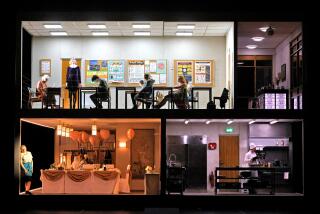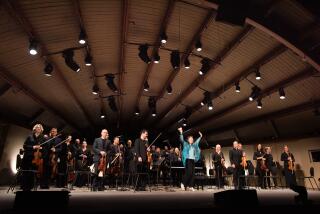Not afraid to mix it up
- Share via
Maria Schneider’s music is, to the big jazz band styles of the 20th century, what Debussy and Ravel were to the orchestras of Wagner and Strauss. That is, using familiar jazz band instrumentation -- sections of trumpets, trombones, saxophone and rhythm -- Schneider is reaching beyond the typical high-energy textures of the past in search of subtle new gradations of color and emotion, informed by impressionistic musical transparency.
Schneider brought her Jazz Orchestra to Disney Concert Hall on Wednesday with a program defining her unique style, its multiple pleasures, and its importance to contemporary jazz.
Given the fact that the performance took place while the Grammy Awards show was nearing its conclusion just a few miles away, it seemed fitting that the 45-year-old band leader opened her program with “Concert in the Garden,” the title piece from the CD that led to her first Grammy a year ago.
That number set the pattern for two of the most noteworthy aspects of Schneider’s music: unusual tonal textures and prominent room for soloists.
A few pieces reflected her fascination with unusual rhythms: “Choro Dancado” (based on the classic Brazilian choro beat) and “Aires de Lando” (inspired by the lando rhythm of Peru).
Others underscored her penchant for programmatic impressionism: “Journey Home,” with its references to her Minnesota roots; “Hang Gliding,” describing a soaring flight from the hills above Rio de Janeiro.
Virtually every piece allowed room for a stunning array of first- rate soloists, especially trumpeters Ingrid Jensen and Greg Gisbert; saxophonists Rich Perry, Steve Wilson and Donny McCaslin; guitarist Ben Monder and pianist Frank Kimbrough. Baritone saxophonist Scott Robinson was also featured on clarinet in “Aires de Lando” (commissioned by the L.A. Philharmonic).
A slender, elegant-looking woman who once trained as a dancer, Schneider led her ensemble with graceful gestures, the subtleties of her conducting movements clearly bringing extraordinary layers of dynamic intensity to the performance.
Like the music of her most obvious predecessors -- Duke Ellington and her mentor, Gil Evans -- Schneider’s reaches toward a significant new level of imagination, making hers the first truly novel approach to big jazz band composition of the new century.
More to Read
The biggest entertainment stories
Get our big stories about Hollywood, film, television, music, arts, culture and more right in your inbox as soon as they publish.
You may occasionally receive promotional content from the Los Angeles Times.










